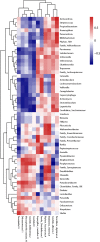The mycobiome of root canal infections is correlated to the bacteriome
- PMID: 27771826
- PMCID: PMC5442261
- DOI: 10.1007/s00784-016-1980-3
The mycobiome of root canal infections is correlated to the bacteriome
Abstract
Objectives: Bacterial infection of the root canal system causes apical periodontitis. Less is known about the role of fungi in these infections. This study aimed to assess the fungal prevalence, abundance, and diversity of root canal infections, as well as the relation between fungi and bacteria present in different parts of the root canal.
Materials and methods: Twenty-six teeth with primary apical periodontitis were extracted, split in apical and coronal root segments, and cryo-pulverized. Bacteriome profiles of 23 teeth were analyzed based on the V3-V4 hypervariable region of the 16S ribosomal RNA gene. Mycobiome profiles of six teeth were analyzed based on the internal transcribed spacer (ITS) 1 or ITS2 region. Samples were sequenced on the Illumina MiSeq platform.
Results: A total of 338 bacterial operational taxonomic units (OTUs), 28 ITS1 OTUs, and 24 ITS2 OTUs were identified. Candida and Malassezia were the most frequently identified fungi. No differences could be found between the bacteriome and mycobiome profiles of the apical and coronal root segments. The bacteriome of fungi-positive root segments contained more Actinomyces, Bifidobacterium, four different Lactobacillus OTUs, Propionibacterium, and Streptococcus. A Spearman correlation matrix between bacteriomes and mycobiomes identified no correlations, but separate clusters could be observed.
Conclusions: A considerable proportion of the root canal infections contain fungi, although fungal diversity is limited. However, when fungi are present, the composition of the bacteriome is clearly different.
Clinical relevance: Interaction between bacteria and fungi in root canal infections may complicate the infection and require alternative treatment strategies.
Keywords: Bacteria; Fungi; Microbiome; Next-generation sequencing; Primary endodontic infection.
Conflict of interest statement
Conflict of interest
The authors declare that they have no conflict of interest.
Funding
This study was funded by the authors and their institutions.
Ethical approval
This article does not contain any studies with animals performed by any of the authors. All procedures performed in studies involving human participants were in accordance with the ethical standards of the institutional and with the 1964 Helsinki declaration and its later amendments.
Informed consent
Informed consent was obtained from all individual participants included in the study.
Figures




References
-
- Matsumiya S, Kitamura M. Histopathological and histobacteriological studies of the relation between the condition of sterilization of the interior of the root canal and the healing process of periapical tissues in experimentally infected root canal treatment. Bull Tokyo Dent Coll. 1960;1:1–19.
MeSH terms
Substances
LinkOut - more resources
Full Text Sources
Other Literature Sources

